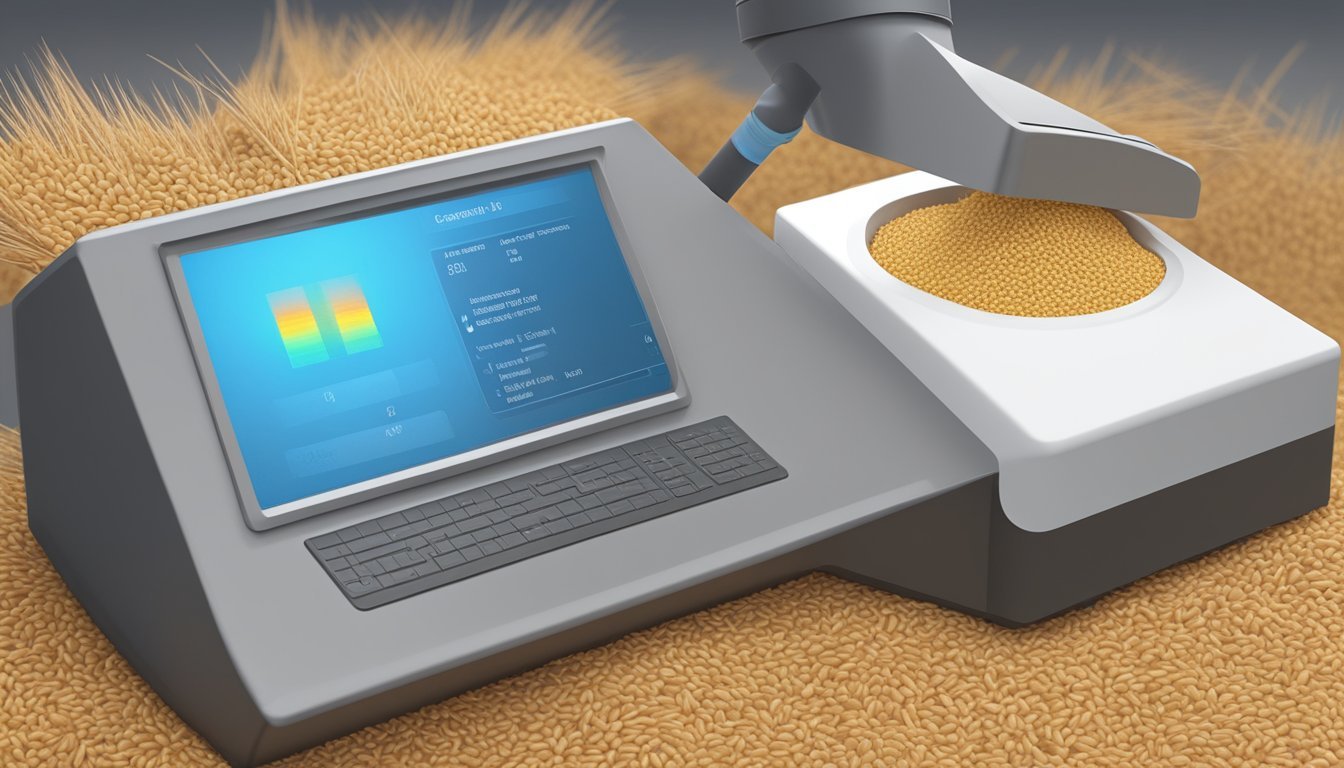How to Use a Grain Protein Analyzer for Optimal Harvest Quality Assessment
Assessing the protein content of harvested grain is a critical step for farmers and grain processors alike, determining the value and suitability of the crop for various end uses. A grain protein analyzer is an invaluable tool for this purpose. It provides rapid, accurate assessment of protein levels on a consistent moisture basis, typically 12% for wheat. This immediate analysis allows for informed decision making regarding the segregation and utilization of the grain, ensuring that quality standards are maintained and that the best possible market price is achieved.
Grain protein analyzers utilize Near-Infrared Reflectance (NIR) technology. The instruments, including models such as the Foss Infratec 1229, Infratec 1241, and Infratec Nova, are designed to perform non-destructive testing, thereby preserving the sample. They are key in measuring protein content which is an essential indicator of grain quality and directly influences the nutritional value and baking characteristics of the crop.
The adoption of a grain protein analyzer in the post-harvest process streamlines the quality assessment procedure. Not only does it provide immediate feedback on the protein content, but it also allows for the broader assessment of grain quality by enabling the operator to conduct additional tests for moisture, oil, and starch content, using the same equipment. This comprehensive analysis is beneficial for tailoring the grain for specific processing needs and for maximizing returns from the harvest.
Understanding Grain Protein Analyzers
Grain protein analyzers are essential tools for measuring the protein content in grain, which is a key indicator of grain quality. These devices offer various features and operation methods adapted to specific analysis needs.
Principles of Operation
Grain protein analyzers operate primarily through near-infrared (NIR) technology, which measures the absorbance of NIR light by grain samples. The absorbance correlates with the composition of the grain, allowing the analyzer to calculate levels of protein, moisture, and oil. This process is carried out quickly, usually in less than a minute, providing rapid and accurate results.
Importance of Protein Measurement
Measuring protein content is vital as it determines the grain's end-use and market value. High-protein grains are often associated with better bread quality and higher nutritional value, making such analysis critical for farmers, traders, and processors to optimize the value of their harvest.
Different Types of Analyzers
Grain protein analyzers come in several forms, each designed with particular features to address specific measurement contexts:
Portable Analyzers: These are compact and can be used directly in the field, making them a cost-effective choice for immediate analysis.
Benchtop Systems: More suitable for laboratory environments, they tend to be more comprehensive and can usually measure a wider range of parameters with high accuracy.
Rugged Analyzers: These are designed for durability and are ideal for use in challenging field conditions.
Each type aligns with different operational needs, from on-the-spot assessments to detailed laboratory-based analysis.
Preparing Grain Samples
Accurate grain sample preparation is crucial in determining the quality of the harvest using a protein analyzer. These steps ensure that the data reflects the true variability of the grain lot and meets high standards for quality control.
Sample Collection Methods
One must collect grain samples representatively to minimize variability and maintain quality control. Standardized techniques should include:
Random Sampling: Drawing grain from multiple locations within the silo or container, not just from the top or bottom layers.
Automatic Sampling: Utilizing mechanical systems to ensure consistency and reduce human error during collection.
Handling and Storage
Proper handling and storage of samples are vital to maintain the integrity of the analysis. One should:
Minimize Exposure: Keep samples in airtight containers to protect against moisture and contaminants.
Label Clearly: Use labels to record data like harvest date, silo number, and other identifiers for traceability.
Conditioning the Samples
Before analysis, samples must be conditioned to a standardized state to reduce error:
Temperature Equilibration: Bring samples to a consistent temperature relevant to the grain analyzer’s requirements.
Moisture Content: If needed, adjust the moisture content to the standard level for the type of grain being analyzed.
Analyzing the Quality of Grain
Grain quality assessment is crucial for determining the market value and suitability for specific uses. This section explains how to use a grain protein analyzer to assess these qualities effectively.
Establishing Protocols
To ensure accurate measurements, users should establish strict protocols for using the grain protein analyzer. Initially, calibration of the device is vital, using standard sets to account for variations in grain type. Samples must be collected systematically across the stored grain to avoid sampling error (representative sampling). Users should also standardize the preparation of these samples, which often involves grinding the grain to a consistent size and ensuring a uniform moisture content before analysis.
Interpretation of Results
After performing the analysis, interpreting the results correctly is key. The grain protein analyzer provides several metrics, including total protein content, which is a primary indicator of grain quality especially for wheat and barley. The analyzer can also provide data on moisture content, as grain with higher moisture is more prone to spoilage. Users must be aware of acceptable ranges for each parameter:
Protein Content: Varies depending upon grain type; commonly, a higher percentage indicates better quality for milling and baking.
Moisture Content: Critical for storage; typically should be below 14% to prevent fungal growth.
Density: Reflects physical attributes affecting milling yield and flour quality.
Quality Parameters
The quality of grain is assessed based on a combination of parameters:
Protein Content: Indicates nutritional value for human and animal consumption.
Moisture Content: Affects storage longevity and susceptibility to spoilage.
Chemical Composition: Encompasses protein along with starch and fiber contents, which affect processing behavior and end-product quality.
Total Protein: It is correlated with the essential amino acids composition and is a significant determinant in setting the grain price.
Careful analysis of these factors using a grain protein analyzer helps in categorizing the harvested grain for appropriate end-use, ensuring that growers can maximize their crop's value based on its quality.
Optimizing Crop Management
Effective crop management integrates soil and crop analysis, fertilization strategies, and variety selection to maximize both yield and grain quality. These components work synergistically to enhance grain protein content, which is a key indicator of grain quality analyzed using grain protein analyzers.
Soil and Crop Analysis
Crop managers must prioritize detailed soil and crop analysis to ensure optimal growing conditions. Utilizing soil maps and precision agriculture techniques, they can obtain precise data on soil fertility and variability. Soil tests should focus on macronutrients and micronutrients to guide fertilization strategies. Accurate protein maps created from prior harvests help understand the protein distribution within fields, informing targeted interventions.
Primary analyses include:
Macronutrient levels (e.g., N, P, K)
Soil pH and EC (Electrical Conductivity)
Organic matter content
Micronutrient availability
Fertilization Strategies
Tailored fertilization strategies are vital in optimizing grain quality. Applying the correct amount and type of fertilizer can significantly influence grain protein levels. Crop managers often apply nitrogen (N) during critical growth stages—between tillering and stem elongation—to boost protein synthesis. They must also balance fertilizer use to prevent overapplication, which can lead to environmental issues and suboptimal nutrient use efficiency.
Key considerations for N fertilization:
Rate: Apply the correct amount of N.
Timing: Align N applications with growth stages.
Type: Select appropriate forms of N fertilizer.
Precision: Employ GPS-guided equipment for precise applications.
Variety Selection
Selecting the appropriate variety of crop is critical for achieving high grain yield and desirable grain protein content. Different varieties possess intrinsic qualities that interact with the environment and management practices. Crop managers should choose varieties known for high protein potential and adaptability to local soil and climatic conditions.
Factors affecting variety selection:
Genetic protein potential
Disease resistance
Adaptability to soil types
Response to fertilization
By focusing on these elements, crop managers can use grain protein analyzers to assess and validate the effectiveness of their management strategies, leading to a high-quality harvest.
Impacting Factors on Grain Protein
Grain protein content is a critical quality characteristic influenced by a complex interplay between environmental factors, genetic variability, and various agronomic practices. Understanding these influencing factors is essential for optimizing grain quality.
Environmental Conditions
Nitrogen availability: It is the cornerstone that affects both grain yield and grain protein content. Adequate nitrogen levels lead to a positive correlation with protein content, as proteins are nitrogen-rich compounds.
Water: Water availability has a significant impact on grain development. Drought can induce a negative correlation with yield, though it may lead to higher protein content due to lower overall grain fill which concentrates the protein.
Genetic Variability
Genotype: The genetic makeup of a cereal crop determines its potential for grain protein content. Different varieties exhibit varying levels of protein based on their genetic predisposition.
Maturity: The time it takes for a grain to reach maturity also plays a role. Varieties with shorter growth periods may have different protein content levels compared to those with longer maturation times.
Agronomic Practices
Nitrogen management: The timing and method of nitrogen application are pivotal. A strategy that provides nitrogen at critical growth stages is more likely to enhance protein content.
Soil properties: The nutrient composition and pH level of the soil can influence how well nitrogen is utilized by the crop, therefore impacting the protein content of the grain.
Deploying Protein Analyzers in the Field
Deploying protein analyzers in the field enables farmers to measure grain protein levels on-site, leading to informed decisions about harvest timing and yield optimization. The integration with harvest equipment and real-time protein mapping further advances precision agriculture practices.
On-Farm Usage
Farmers use portable grain protein analyzers to conduct spot tests in the field, determining the best time for harvest. These handheld devices are designed for on-the-go testing, offering a fast and reliable method to assess the protein content directly within the farm's boundaries.
Integration with Harvest Equipment
Many grain protein analyzers can be integrated with a combine harvester, allowing for seamless assessment of protein content during the harvest itself. This integration typically involves:
Ease of installment: devices that fit into the cabin or attach to the combine.
Data collection: seamless sync with the combine's existing systems to collect data while harvesting.
Efficiency: maximized by analyzing grain samples immediately as they are gathered, streamlining operations and saving time.
Real-Time Protein Mapping
With the aid of GPS technology, grain protein analyzers can produce protein maps of fields in real time. This precise mapping helps farmers identify variations in protein content across different field zones and understand how factors like topography and soil composition affect grain quality. Real-time protein mapping is a key tool in precision agriculture, aiding in:
Spatial analysis: developing a visual representation of protein content distribution.
Decision making: applying variable rate fertilizer or planning targeted interventions for subsequent growing seasons.
Maximizing Economic Returns
The utilisation of a grain protein analyzer is integral in assessing grain quality, which directly correlates with market demands and profitability. Farmers can leverage this technology to enhance decision-making processes for increased economic returns.
Market Trends and Protein Demand
Protein content in grains, especially in crops like wheat and barley, is a significant factor influencing market prices. Protein levels are often used as a benchmark for quality by buyers, dictating the market value of the harvest. Awareness of current market trends and the demand for high-protein grain aids farmers in timing their sales to maximize profits. For instance, if there is a surge in demand for high protein content, farmers can adjust their nitrogen application based on grain protein analysis to meet these market needs.
Profitability and Efficiency
The use of a grain protein analyzer enhances nitrogen use efficiency, potentially leading to cost savings on fertilizers and improved grain yields. By understanding the protein levels in their crops, farmers can:
Adjust nitrogen applications: Precise applications ensure crops receive optimal nutrients without wastage.
Manage Resources: Resources are allocated efficiently across different farm sections, targeting areas that will yield the most profitable return.
The economic returns extend beyond the current growing season as well, as data from protein analyzers can guide future planting decisions, storage conditions, and resource allocation.
Decision-Making and Storage
Grain protein analyzers empower farmers with valuable data to make informed decisions regarding the storage of their grain. Storage decisions have a profound impact on maintaining grain quality and profitability over time. High-quality grain might be stored in a silo for later sale when the market conditions are more favorable, or conversely, sold immediately if the grain quality might degrade or if market trends indicate favorable conditions. The information gleaned from protein analysis ensures that grain handlers and farmers are equipped to make strategic decisions that protect their profit margins and maintain the quality of their produce.
Technological Advances and Future Trends
As grain protein analyzers become more sophisticated, they are an invaluable tool for farmers and agronomists. By leveraging state-of-the-art technology, these devices are setting new standards in grain quality assessment.
Innovations in Protein Analysis
Recent years have seen significant innovation in the field of grain protein analysis. One such development is GrainSense, a handheld device designed to provide instant measurements of grain protein content in the field. These advancements allow for immediate decisions regarding crop management and harvest timing, leading to improved grain quality.
Features of Modern Grain Protein Analyzers:
Portability: Devices can be used directly on the farm.
Speed: Instantaneous results reduce the need for lengthy lab tests.
Accuracy: Enhanced sensors offer precise protein content readings.
Sustainability and Precision Agriculture
The integration of protein analyzers into precision agriculture reflects a shift toward sustainable farming practices. By pinpointing the nutritional content of grains, farmers can optimize the use of fertilizers, minimizing environmental impact. In regions such as Montana, precision agriculture has been instrumental in fine-tuning farming tactics to the local climate and soil conditions.
Benefits of Protein Analyzers in Precision Agriculture:
Resource Management: Tailored nutrient application reduces waste.
Yield Optimization: Farmers can maximize output by using detailed grain quality data.
Global Perspectives on Grain Quality
In the global market, the demand for high-quality grain is universal, but the approach to achieving it is local. In countries like India, protein analyzers are becoming crucial in maintaining grain quality to meet both domestic consumption and export standards. Accessibility to advanced technology empowers countries to elevate their grain quality on an international scale.
Implementing Grain Protein Analyzers Globally:
Improving Food Security: Robust grain quality can lead to greater self-sufficiency.
Enhancing Market Value: High protein content is a key selling point in the competitive grain trade.




